11 Best Beers To Dye Green For St. Patrick's Day
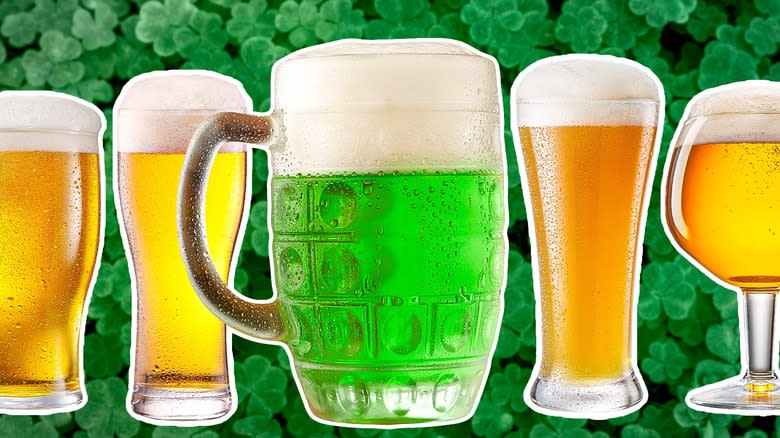
St. Patrick's Day is the day the world turns green. Once a year, on March 17th, the green light is lit on a holiday that puts the "I" in Irish, no matter your actual background. That also means that St. Patrick's Day is one that's circled on the calendar for beer lovers as one of Ireland's favorite beverages comes to the forefront. In the U.S. and many other countries that give St. Paddy's a proper go, it's not just the clothing and decor that can turn green but the beer itself.
The tradition — maybe not so much tradition as a practice — of dyeing beer green for St. Patrick's Day has been around for over a century. Examples of emerald-hued brews have been recorded as early as 1910. This March 17th, a Spokane, Washington bar had what sounds like a rollicking St. Paddy's with a busy bartender pouring mysteriously tinted green beer from one of his taps all day long.
While this bartender's secrets remain lost in the tomes of St. Patrick's Days past, we have modern-day experts to help us navigate the best beers to dye green for St Patrick's Day. Jane Street is the Assistant Venue Manager at Archie Brother's Cirque Electriq in Melbourne, Australia, and has experience as a craft beer brand and festival manager. Cody Fowell is another Melbourne-based bar manager at Lucy Liu Restaurant and has 13 years of hospitality experience to guide us on our journey through the world of green beer.
Read more: The 40 Absolute Best Cocktails That Feature Only 2 Ingredients
What Is Green Beer For St. Paddy's Day?
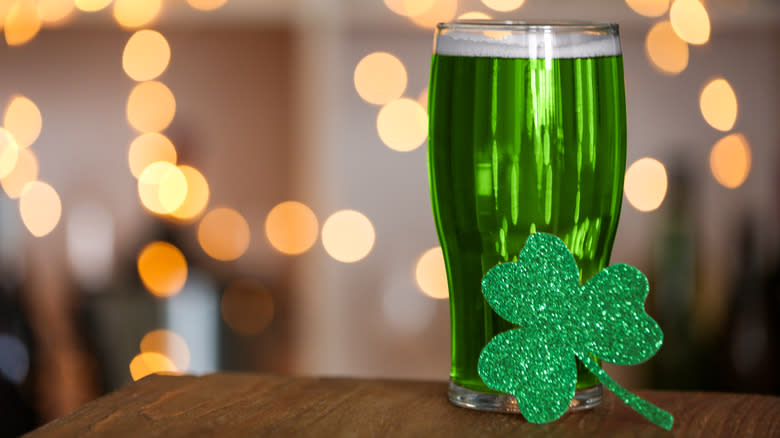
There are many routes to a festive St. Paddy's Day, whether you're digging out your green pants or you've found some recipes to kick off your St. Patrick's Day celebration. Turning beer green is a fun way to inject even more festivity into this high-energy holiday while staying on theme.
Jane Street recommends using spirulina to turn your beer green but warns that style selection is key. "It has a real earthiness to it, so perhaps you'd like to wizz a little bit into your sweeter style mango or tropical fruited sour beers."
Cody Fowell suggests another alternative. "I found pandan extract did an excellent job turning beer green but overpowered the lager I initially tried it with." This is a derivative of the pandan leaf, a common ingredient in Southeast Asian cuisine that lends its distinctive vanilla-like flavor and aroma, as well as its green hue. Fowell recommends choosing stronger tropical pale ales and only using a drop or two of extract for best results.
To avoid the hassle, Fowell has a simple recommendation: "Unflavoured green food coloring is your safest bet when tinting your beer." Street's approach with food coloring is to "close our eyes, have a sip, and think about the beers that taste kind of green." This means reverse-engineering the process by choosing beer styles with "green" flavors, such as piney or floral notes, to curate a cohesive drinking experience. If it already tastes green, it should look green, right?
Wheat Beer
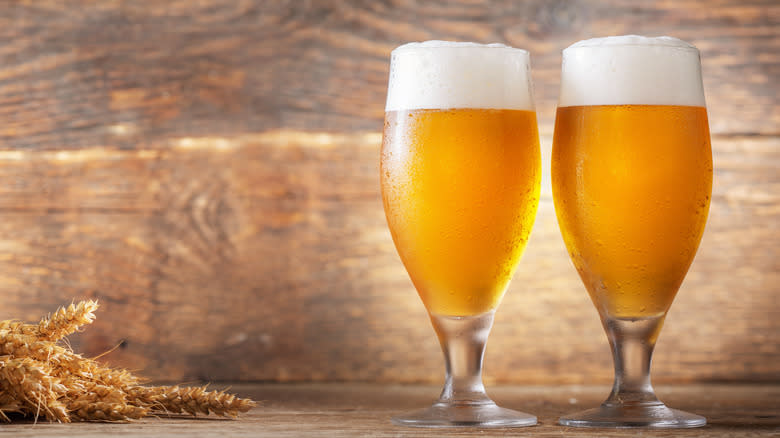
The first recommendation on this list is one of the lightest in color. As Fowell describes, "Quite simply, the lighter the beer, the easier it's gonna be to turn it green." This makes wheat beer a prime candidate for greening up on the big day. Not only is wheat beer very light in color, but it can be cloudy, meaning that it holds the green tint well.
Wheat beers are predominantly comprised of wheat in the grain bill. Other grains, such as barley, rye, or oats, can join the mix, but for these beers, wheat is front and center. Typically, beers in this category are at least 50% wheat. This means you don't just have to eat Irish beer bread, but you can drink it, too.
Wheat beer is distinguished by the flavors that its titular grain offers, as well as what it gets from the yeast that feeds on its sugars during fermentation. Common flavors to enjoy in wheat beer include ripe banana, bubblegum, or even cooking spices. Good news for fans of pandan, as these flavors make wheat beer a perfect candidate for a drop or two of Fowell's vanilla-like pandan extract. Wheat beers are typically not as bitter or hoppy as other styles, making them easy to enjoy for the duration of the night.
Lager
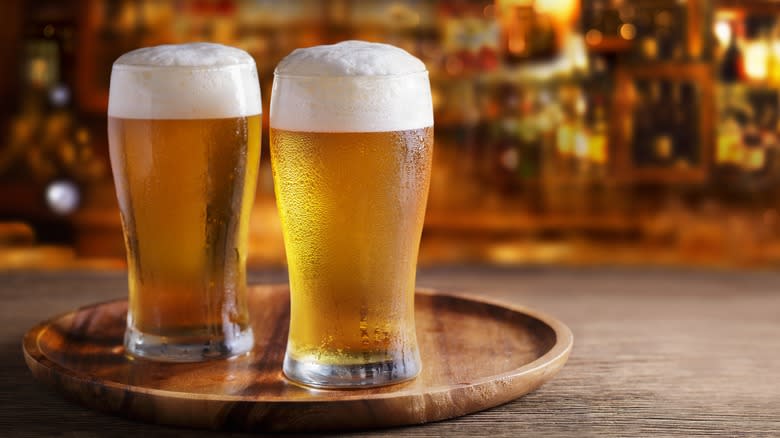
Lagers are possibly the most pervasive beers to turn green on St. Paddy's Day, not because they're necessarily the best at being green, but simply because it's the most common beer style for bargoers. According to Statista's July 2022 survey, 43% of beer lovers in the U.S. chose lager that year. Another nugget of advice from Fowell was to choose a beer that you actually like drinking and stick with that. After all, the aim is to enjoy yourself.
Straight-up lager usually has a low level of bitterness. It's also drier on the palate thanks to its yeast strain and colder fermentation temperature (differentiating lager and pilsner from the other styles on this list that use ale yeast). This makes lager incredibly sessionable, being crisp and refreshing.
It's easy to see why lager is so popular for a green pint on St. Patrick's Day. It's light in color and clear, meaning a big glass of green lager dresses up well for the occasion. It also means that unflavored food dye is your best bet for turning your beer green without overpowering its flavors. Note, however, that you only need a few drops of food coloring to get the job done. Too much dye in your drink and you may end up with a green smile all night long. Harp Lager held the entry-level spot in our ranking of 9 Irish beer brands and is the obvious choice of Irish lager for your St. Paddy's celebrations.
Pilsner
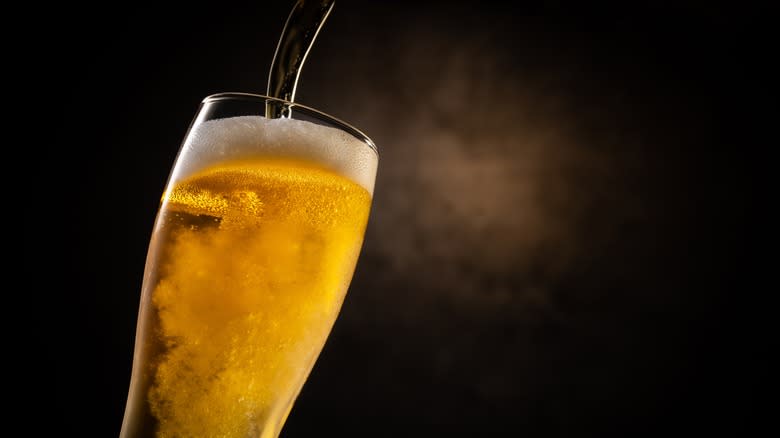
Pilsner is just a little hop (pun intended) way from lager and offers many of the same benefits for a green St. Paddy's Day pint. In fact, pilsners are a type of lager made from the same bottom-fermenting yeast at colder temperatures. Originally a product of the Czech Republic and named after its city of Pilsen, this beer style is a popular version of lager that has inspired local variations around the world.
Pilsners tend to be crisp with a bready or biscuity malt flavor, although they have a notable bump up in the presence of hops. Classically, pilsners use a noble (basically meaning old-school) family of hops called Saaz hops, which impart herbaceous or spicey notes. Contemporary pilsners may use any variety of hops, which are usually restrained yet present in the flavor profile and aroma of the beer. Just like other lagers, pilsner's clarity, approachability, and light color make them a great option for a festive green beer. Similarly, green dye is the most suitable option here for a bright and eye-catching emerald pint.
Belgian Witbier
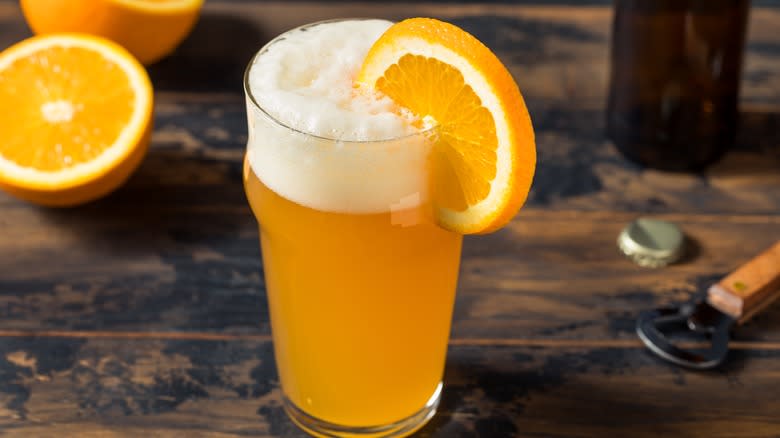
Witbier is a style popular in Belgium that adds a little spice to the wheat beer category. This sibling in the wheat beer family gets its own spot on this list because it has a few distinguishing characteristics that might influence your greening strategy. What makes witbier special is that it can often be brewed in the traditional fashion using coriander seeds and orange peel, which add extra complexity and refreshment to its light and bready profile.
Hoegaarden is a popular brand of witbier you can find around the world that's thick and cloudy enough to hold a bright green tint. While the fruitier notes that the yeast imparts welcome the addition of vanilla flavor in pandan, this extra element can be too much for some on top of the citrus and spices. Food coloring may be a safer choice to avoid a range of flavors wrestling each other for dominance. Ultimately, experimentation is the best approach. You may just love a witbier with that extra pandan flourish.
Witbier has a moderate alcohol level, ranging between around 4.5% to 5.5% ABV. Fowell points out that this is an important factor when planning your St. Patrick's Day consumption, recommending a good pan beer in the range of 4% and 6% ABV. Choosing beer with a merciful level of alcohol can help make your St. Paddy's Day celebrations last that much longer.
Cream Ale
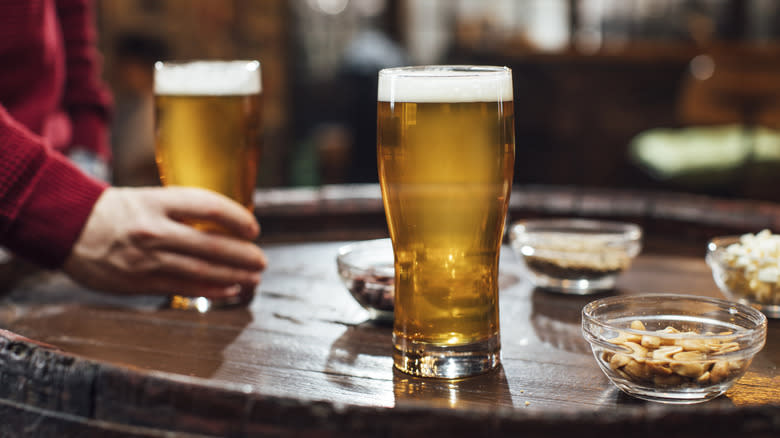
The name cream ale can be somewhat misleading. They, in fact, have nothing to do with cows and even straddle the definition border between lagers and ales. Cream ales are light, clear, and refreshing beers that are wholly inoffensive and highly quaffable.
Understanding what a cream ale is involves a period of head-scratching, but put simply, they're ales that are taught to behave as lagers throughout the brewing process. Just as Tarzan was raised by the apes, these are ales that are influenced by combining the yeast, temperature, and ingredients that typically produce lagers. The result is a beer with the best of both styles — a touch more flavor than your typical lager but with more levity and crispness than an ale. This is an American invention created in the 1840s to compete with Europe's fuller-flavored lagers and is enjoying a craft-brewed renaissance.
To paint this beer green, the same approach as lagers works a treat. A few discreet drops of food coloring can turn the light golden hue a rich green. Because this beer has a slightly yellow appearance, using blue dye can give you better results than green food coloring. The blending of blue dye and golden liquid makes a brighter green tone in the beer.
Amber Ale
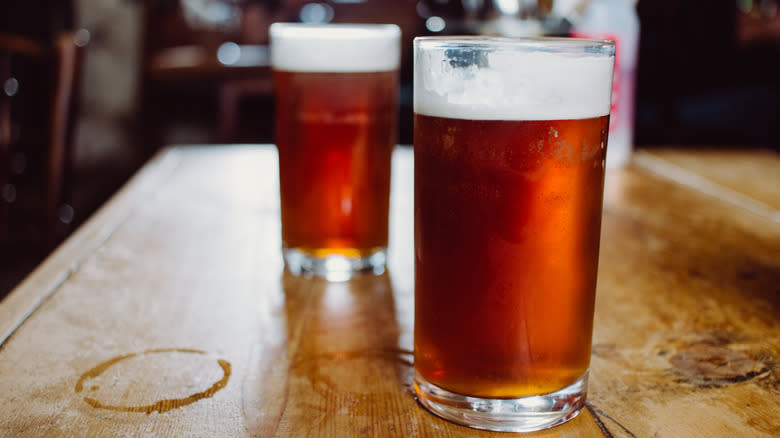
This next beer style requires some creativity, but the visual rewards are well worth it. Unlike the lighter-hued beers in this list, amber ales are too dark to easily get a satisfying green tint by mixing with extract, dye, or powders. What amber ale does have is a copper color, matching the orange that comprises a third of the Irish flag. By employing a few extra steps and stylistic flair, you can create a layered beverage representing the Republic of Ireland's orange, white, and green.
Amber ales are malty and rich, with notes of caramel and toasted barley. They can also be decently hopped without being predominantly bitter. These are full-flavored and moreish brews that can range from around 4.5% to 6% ABV, making them highly sessionable.
To create the Irish flag beer, you need an amber ale with decent head retention. That means a beer that keeps a nice foamy head for a while after being poured. Tip a small amount of your beer into a mixing bowl and add only a drop of green food coloring. Whisk this beer until it forms a green foam. If you have an immersion blender, this can give you even better results. Pour your amber ale into a glass, giving it enough turbulence to form a reasonable head of its own. Then, spoon the green foam over top, creating three distinct green, white, and orange layers.
XPA
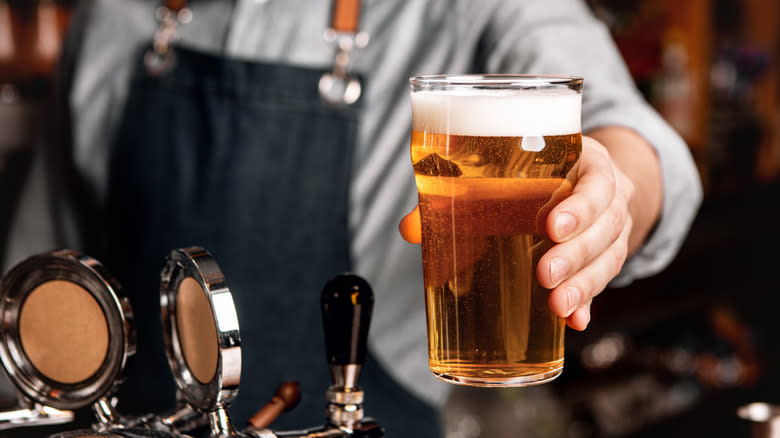
An XPA, or extra pale ale, is a contemporary style of beer with a definition that's tricky to pin down. At its core, an XPA is a pale ale that is...well, extra pale. In 2008, when the XPA first debuted in Oregon's fizzing craft beer scene, the word "experimental" gave the beer its X. Now, although pushing category boundaries is still a feature of the style, the words extra and pale tend to stand together. This makes it an excellent beer of choice for dyeing green.
In terms of flavor, it's a bit harder to define what's so extra about these pale ales, as there is no one definition across breweries. Some may have the hoppy punch of a pale ale but with less dark, roasty malts in the mix. Others may resemble the malt base of a lighter-hued IPA, just without as much bitterness. Regardless, for the purpose of a green beer with more flavor intensity than a lager or a cream ale, an XPA is a versatile option.
A few restrained drops of blue food dye for those XPAs with a more yellow hue will do the trick. Lighter versions of the style can likely work with green food dye as well. The color of your beer can tell you much about your beer, but there's more than one way to dye a cat when it comes to diverse styles like the XPA.
IPA
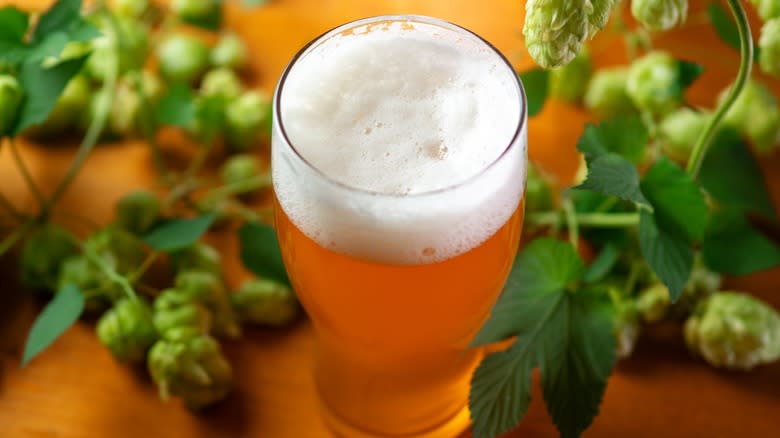
IPAs, or India pale ales, are big, bold, hop-forward beers that deliver big flavor. They're so-named from the historical period in which beers were shipped to India from Britain during the 18th century. Loading the casks up with fresh hops helped the liquid stay fresh longer and the extra hops acted as a preservative on these long and grueling journeys. Nowadays, after the craft explosion, the IPA has remained one of the most popular styles of craft beer.
There's a huge variety of IPA styles to enjoy, so Street's advice is to seek those out with green flavors so as not to create cognitive dissonance between your mouth and your eyes. She recommends choosing a beer hopped with varieties that offer piney, floral notes like the aptly named Green Bullet. "If you opened your eyes to find out the beer was, in fact, green it might not shock you too much."
Another good hop variety that Street recommends seeking in an IPA is Mosaic, which "underneath the fruit flavors has some really good grassy, piney notes that will match well with the green colorings of your beer." Go for blue food dye (or green for very light IPAs) to avoid influencing the flavor of the beer. If you don't mind altering the taste, the strength of an IPA's fruity hop flavor makes it a good option for the spirulina method. Mix half a teaspoon of the powder into the beer to give it a thick, dark, and opaque green appearance.
Kölsch
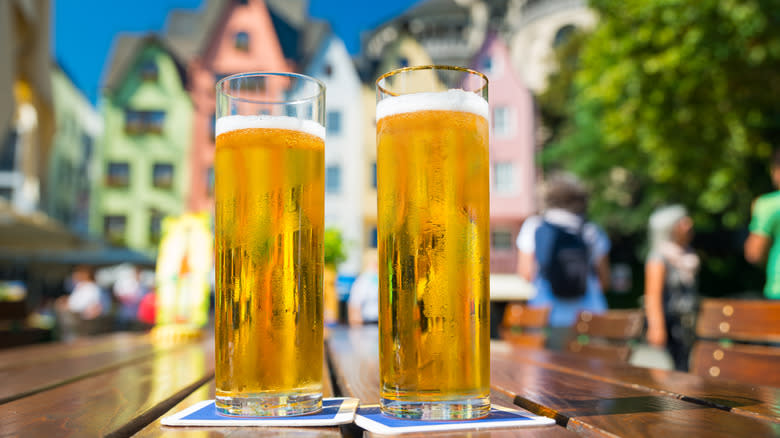
Another one of Street's beer style recommendations is a kölsch because of its smooth and crisp flavor. It's also light in color and clear in appearance, meaning that it makes for a vivid and attractive green beer. A product of Germany, the kölsch is basically the O.G. cream ale, existing as a hybrid of ales and lagers. This style is easy-drinking and refreshing, with just enough hop to elevate the brew and balance the sweetness of the malt.
The kölsch's bright and zippy hop quality, as well as its light malt base, can make it a beer that tastes as green as it looks after a few drops of blue food coloring. Usually falling only half a percent on either side of 5% ABV, this is another sessionable beer that you can stay on for longer. Strictly speaking, kölsch is supposed to be brewed in Köln (that's Cologne), but many craft breweries around the world have embraced the style. Look for a European Union logo on the label to see if it's brewed to the traditional designation standards of the style in Cologne.
Hazy/New England IPA
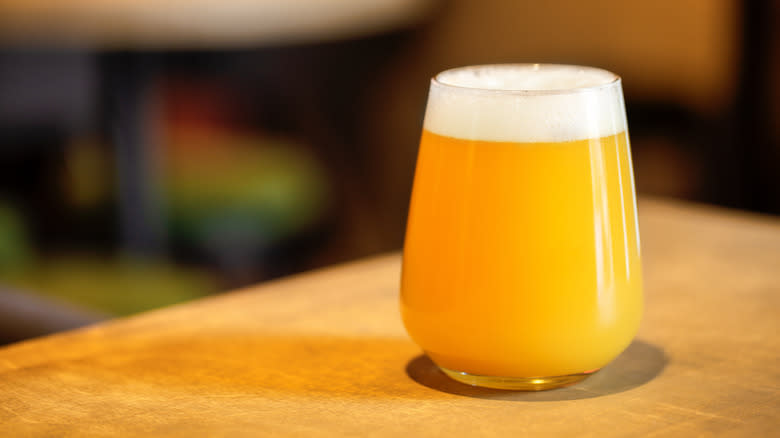
Hazy IPAs and New England IPAs (NEIPAs) blend the best of both worlds, combining big, fruity, and resinous hop flavors with a thick and cloudy viscosity that lends itself to holding a green hue. These are essentially the same as other IPAs, with the key difference being that they're often unfiltered or contain a touch of oats or wheat in the mash to murky up the final product. The difference between hazy IPAs and New England IPAs is as cloudy as the beer itself. Essentially, a New England IPA is a type of hazy IPA, just inspired by the preferred style that has historically emerged from the Northeast. For the purpose of tinting beer green, however, splitting hairs between these two styles isn't necessary.
Both of these styles are big on hops, but not necessarily bitterness. The holy grail of hazy IPAs and NEIPAs is a luscious, silky beer that fills the palate with that magical word — juiciness. The ample presence of fresh tropical fruit flavors over mouth-puckering bitterness makes Fowell's pandan suggestion a great option, as well as Street's spirulina powder, which can suspend satisfyingly in the cloudy beer and balance the fruit with its earthiness. Of course, food coloring will also make for a hassle-free job and give you more control over the hue if that's your preference.
Irish Stout
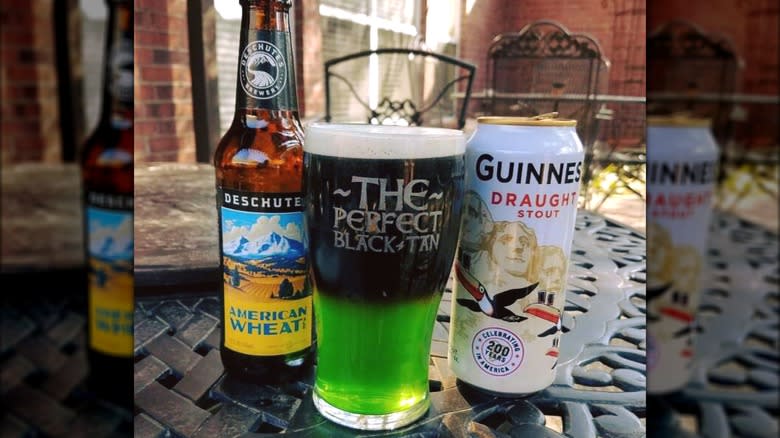
Lastly, let's perform a St. Patrick's Day miracle — turning a pitch-black beer green... kind of. A popular way to enjoy a Guinness is a drink called a black and tan, which suspends half a Guinness over half of a lighter-colored yet denser beer, usually Bass pale ale, settling in two distinct layers. While Guinness and other Irish stouts are difficult to dye green, the pale ale (or another style of lighter beer, such as wheat beer) on the bottom is just a drop of food coloring away from being sham-ready to shamrock.
Knowing how to pour a black and tan is the first key step, as this can be somewhat technical. Using the bowl of a spoon to halt the pour of Guinness and allowing it to form its own layer on top of the ale is key. We recommend mixing the dye into the pale ale before you layer on the Guinness. For all of those who want to enjoy a green beer this St. Paddy's Day but don't want to miss out on Ireland's prized stout, this may be your answer.
Note, however, that in Ireland the name of the black and tan cocktail is actually offensive, as it references the colors of the British paramilitary, which were an aggressive and violent counter to the Irish Republican Army. It's best not to use this controversial name, but this is not strictly speaking a black and tan anyway. What about a new name, like shamrock float?
Read the original article on Tasting Table.


